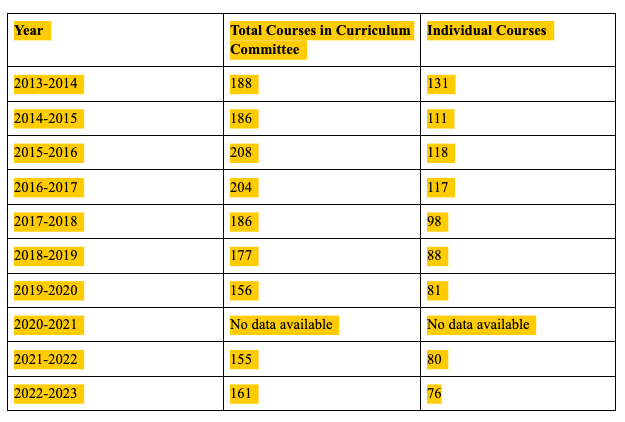Seemingly few options in course selection
The Faculty promotional material lures prospective students with the promise that in upper-years, you will “have the freedom to shape your studies to suit your interests and professional goals.” You can, they claim, choose from “over 180 courses that span the spectrum of legal practice and scholarship.”
Yet, once they arrive, students face a very different reality. For one thing, the numbers are off. For the 2022–23 year, there are at most 161 potential credit options on Cognomos, many of which can’t really bear the title “course.” Accordingly, students themselves feel their options are lacklustre. This year, in particular, students have voiced concerns that they feel forced into classes by both the algorithm and the lack of options.
Don’t just take it from me. Students’ Law Society (SLS) President Meaza Damte (3L) reports receiving “extensive feedback from students indicating that they are disappointed in the course offerings for the 2022–23 academic year.” The SLS has raised these concerns with the administration.
Quantitatively, the course offerings are undeniably a tight fit. Leaving course diversity aside, operating on the assumption that there are roughly 420 upper-year JD students, there are 1,664 available class seats in the Fall semester and 1,651 in the Winter semester this year. This excludes externships, journals, and moots, which are not processed through the usual course selection system. Again, assuming there are roughly 420 upper-year JD students, this leaves approximately 3.9 course spots per student each semester. If we assume that every student will need roughly four classes a semester to hit the credit minimum, this is undeniably cutting it close.
After all, this is based on a number of assumptions. First, that any student is perfectly able to take any class without having any conflicts. Second, that courses with a large number of seats aren’t happening simultaneously. Third, that students don’t have course requirements they need to meet. And of course, it assumes that students don’t care about choosing the classes they take.
The diversity of course options is even bleaker. Although there are 161 total potential courses, 20 of these are moots, which students can only take one of and which are not really courses in any sense of the curriculum definition. Four are journals which, again, require a different sensibility. Several are one-credit workshops, which are merely supplemental to a schedule rather than replacing a full class. Many are externships or internal clinics, which, though beneficial to the student experience and unbelievably important, are likely not part of what the average student would consider a course option (not the least because Cognomos does not allow you to include them in your rankings). Only about half of the options amount to actual, substantive courses offered during the term (see table).
Of course, there are other factors that might affect how students view choice. After all, different sections of classes don’t function as supplemental choices for students because they can’t take both. Still harder to consider as “choices” are courses such as the “Externship Seminar,” which is merely a mandatory accompaniment to an externship. Courses offered for graduate students should obviously be struck. Furthermore, options such as “Supplemental Upper Year Research Paper,” or a “Directed Research Project” where students design their own work, cannot really be considered when assessing the number of classes offered since they exist essentially as opt-outs of courses themselves.
There are essentially 76 courses to choose from. This is…not exactly 180.
It hasn’t always been this way. In 2013, when the Faculty brochure claimed only 130+ classes, there were 188 total credit options, or 131 unique lectures and seminars. That’s 55 more course titles (keep in mind, this is not the number of credits or sections of existing classes), for students to choose from than they can today. Although the Faculty increases the number of JD students every year, the diversity of classes has been declining since 2013. The table below demonstrates this trend, using data from Curriculum Committee reports dating from 2013 (the oldest available online). Total classes prior to 2017 routinely topped 200, until 2019, when they dipped to 156, then 155. In 2016–17, there had always been more than 110 potential classes for students to choose from. In the past four years, there have been only 80. This year has dropped that number further.

Course options aren’t everything. But this represents an undeniable decreasing emphasis on offering students an array of choices in classes, or ways to define their legal careers. Without a diversity of classes, or any real meaningful choice in what they can take, students are inevitably paying for a piece of paper, rather than reaping the benefits of a world-class Faculty and course options that the administration claims justify our tuition. After all, if I’m paying thousands of dollars for a class, shouldn’t I at least get to be interested in it?
Hopefully, we see this trend start to reverse in the coming years. Damte assures that “it is the Students’ Law Society’s position that not only should there be more courses offered next year, they should also be more diverse.”
The Faculty likes to pretend that we are here for the ability to explore legal areas and ideas. If we take away any meaningful choice in the kind of education we pursue, then that educational experience is undeniably being cheapened, despite the growing price tag.





